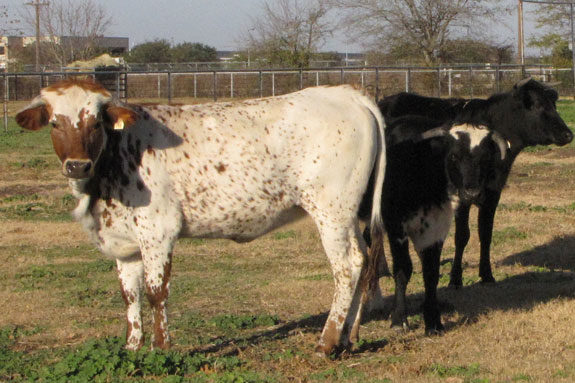A study of an extraordinary family of cow antibodies, led by researchers at The Scripps Research Institute (TSRI) and coauthored by three investigators from Texas A&M College of Veterinary Medicine and Biomedical Sciences (CVM), points to new ways to make human medicines. “These antibodies’ structure and their mechanism for creating diversity haven’t been seen before in other animals’ antibodies,” said Vaughn V. Smider, assistant professor of Cell and Molecular Biology at TSRI and principal investigator of the study.
Antibodies, large proteins in the immune system, resemble lobsters with a tail and two identical arms for grabbing specific targets, called “antigens,” often parts of pathogens like bacteria or viruses.At the end of each arm is a small set of protein loops called complementarity-determining regions (CDRs), which actually do the grabbing.
By rearranging and mutating the genes that code for CDRs, an animal’s immune system can generate a vast and diverse population of antibodies — which collectively can bind to just about any foreign invader.
In humans and in many other mammals, most of an antibody’s specificity for a target is governed by the largest CDR region, CDR H3. Researchers have been finding hints that an unusually long version of this domain can sometimes be the key to a successful defense against a dangerous infection, such as HIV.
Although the structure of the long CDR H3 protein in previous studies of the human anti-HIV antibody seemed unusual, the corresponding structure in the cow antibodies turned out to be unique in the known world of animal antibodies: a long “stalk” element topped by an antigen-binding “knob.”
Sequencing of the DNA that codes for the knob region revealed an unusual abundance of cysteine — a sulfur-containing amino acid that is apt to bond to a nearby cysteine on the same protein chain, thus forming a loop.
Analyses of these DNA sequences, some of which were conducted at Texas A&M, also indicated that in the cow B-cells where these antibodies are made, the knob-coding gene segments are extraordinarily likely to develop point mutations that either add or subtract cysteines.
The effect of these tiny mutations is to create or remove — often radically — antigen-grabbing loops on the structure.
In cows, binding of these antibodies to viruses is almost entirely done by the knob on the long CDR H3, which shows that these antibodies do have an important function in the immune system.
One question remains is why the cow immune system evolved to make such antibodies.
Smider suspects that it has to do with cows’ unusual four-chambered, grass-fermenting stomach with its extensive collection of bacteria and other microorganisms.
“If some of these escape from the stomach and get into the bloodstream or other tissues there could be some pretty serious infections,” he said, “so that’s our starting hypothesis for why cows have this unusual immune defense.”
The study was supported by the American Cancer Society, National Institutes of Health, Skaggs Institute for Chemical Biology, Scripps Translational Science Institute, Texas A&M College of Veterinary Medicine and Biomedical Sciences, and the USDA. PD
—From Texas A&M College of Veterinary Medicine & Biomedical Sciences news release
PHOTO
Some of the cattle used in the research. Photo courtesy of Texas A&M.




